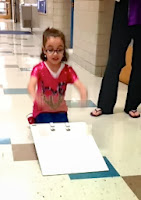Don't forget about this Wednesday's PAGS (Parents of Academically Gifted Students) Event, (I've got my ice cream scoop ready!)
We started our day by discussing scientists and what their job entails. This conversation led us to a basic understanding of the scientific process.
This week the students learned about our first Quirkle Scientist, Inquisitive Inman.
Inman is teaching us about the scientific process. This year I am looking for ways to make our lessons more "inquiry" based.
Inquiry can be defined as the scientific process of engaged exploration. Students will use critical, logical and creative-thinking skills to generate questions they are interested in solving. Our innate curiosity and observations lead us in our inquiry investigations. They will usually include
- Generating a question or problem to solve
- Choosing a plan of action and completing the procedures of the investigation
- Recording the data from our observations and drawing appropriate conclusions
Today, the students were given two toy cars. They began their investigation by carefully examining the the cars. They weighed the cars in grams and measured their length in centimeters.
They also noticed:
- The cars were the same model and color.
- Both cars had 8 windows and 4 wheels.
- All of the wheels had ridges on the surface.

Next, they brainstormed questions they wondered about them:
- Which car is faster?
- Which car goes farther?
- Which car would go higher off of a ramp?
To be sure their cars were released at the same time, they held a ruler in front of them and lifted it to start them down the ramp.
I used an App on my iPhone called Fast Camera to take repeated, quick photos so we could have an accurate, photo finish.
The students repeated the experiment five times to be sure their results were consistent and accurate. They recorded their observations on the experiment form. Analyzed their results and drew their conclusion.
Our results concluded that car #1 rolled the fastest, but as with all good inquiry investigations, we had some new questions:
- Why did car #2 always curve to the right?
- What if we had done our investigation on a different surface rather than the tile floor?
- What if our ramp had been set at a steeper angle?
At the end of our day, the boys and girls went back to our paper: "What Scientist's Do." They cut apart the pictures and matched them to where they used that same action during their experiment.
Today, my students became scientists.
























